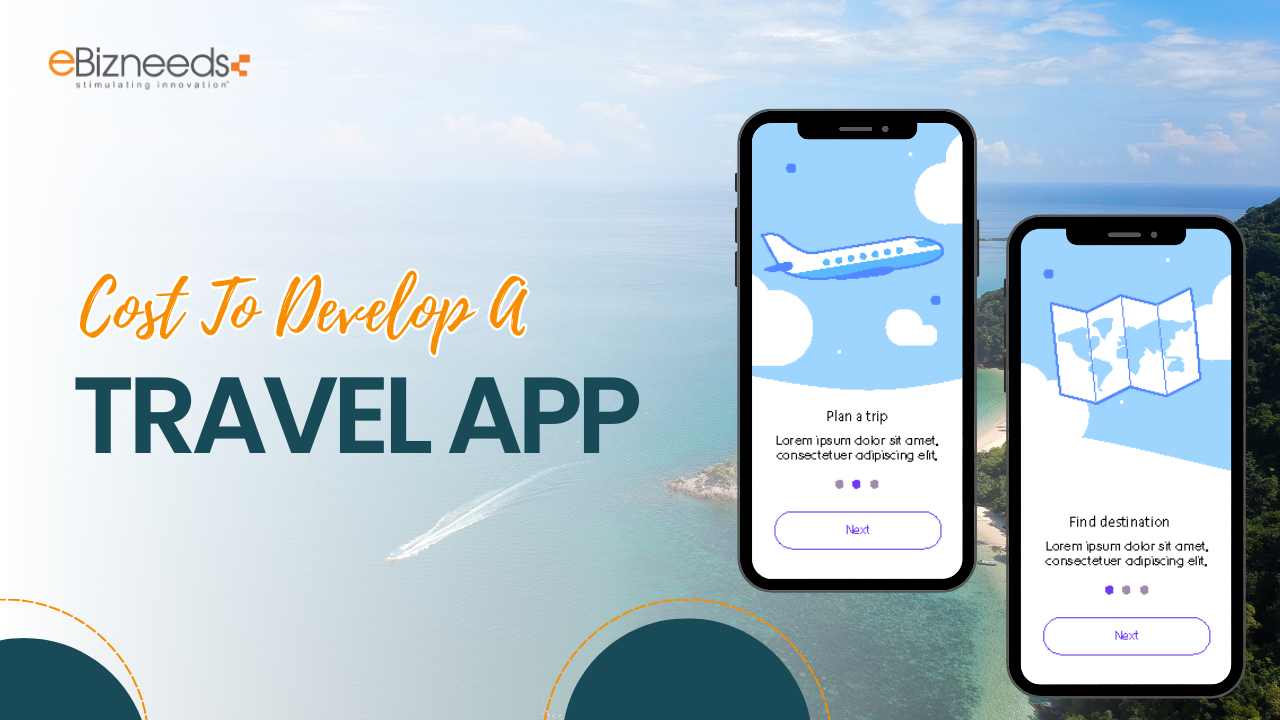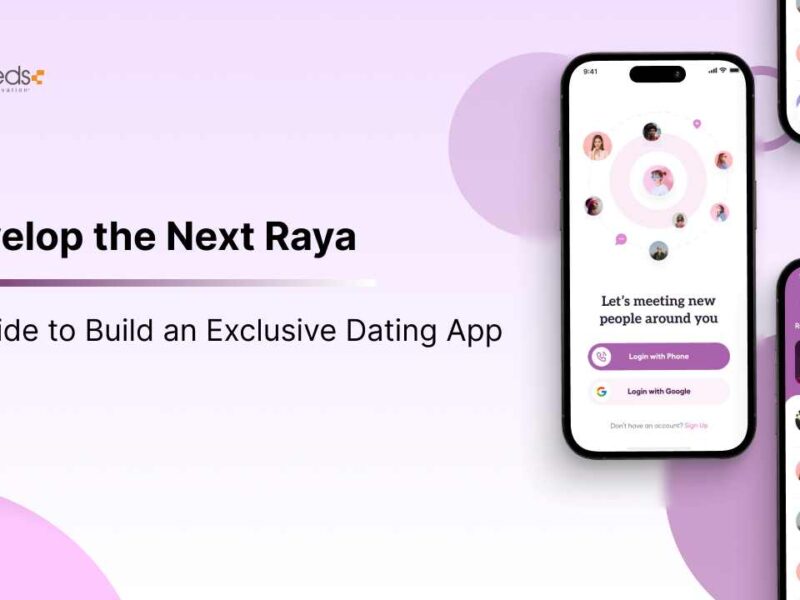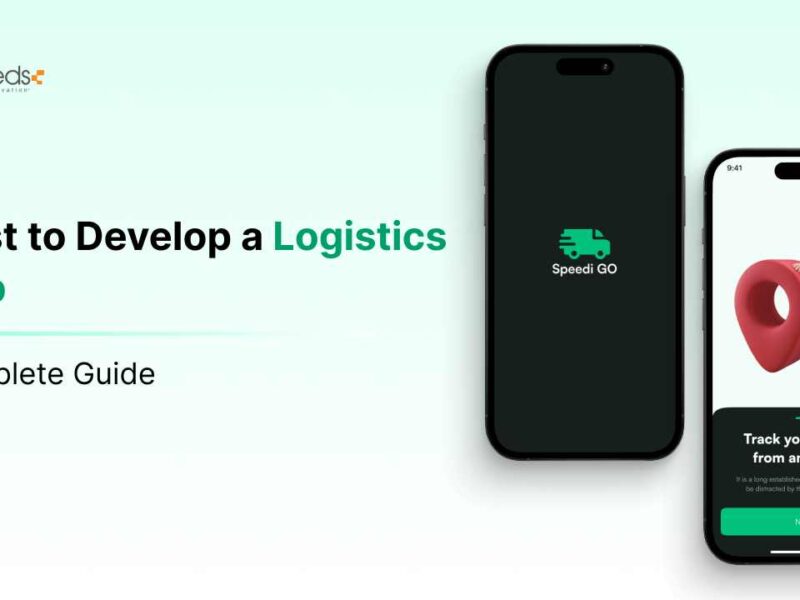If you’ve ever wondered about the cost to develop a travel app, you’re not alone.
With the growing demand for convenient and personalized travel experiences, travel apps have become an essential tool for travelers and businesses alike.
Whether it’s booking flights, planning itineraries, or finding unique accommodations, these apps have revolutionized the way we explore the world.
So, how much does it cost to develop a travel app?
The answer depends on several factors, but on average, it can range from $25,000 to $150,000 or more, depending on the app’s complexity and features.
This wide range often leaves people curious:
What influences the cost? And how can you build a travel app that fits your budget without compromising quality?
In this blog, we’ll walk you through everything you need to know about travel app development costs.
From understanding the factors that impact pricing to exploring ways to reduce expenses, this guide will give you all the insights you need to make an informed decision.
Ready to dive in? Let’s explore why a travel app might be the perfect choice for your business.
Should You Develop a Travel App?
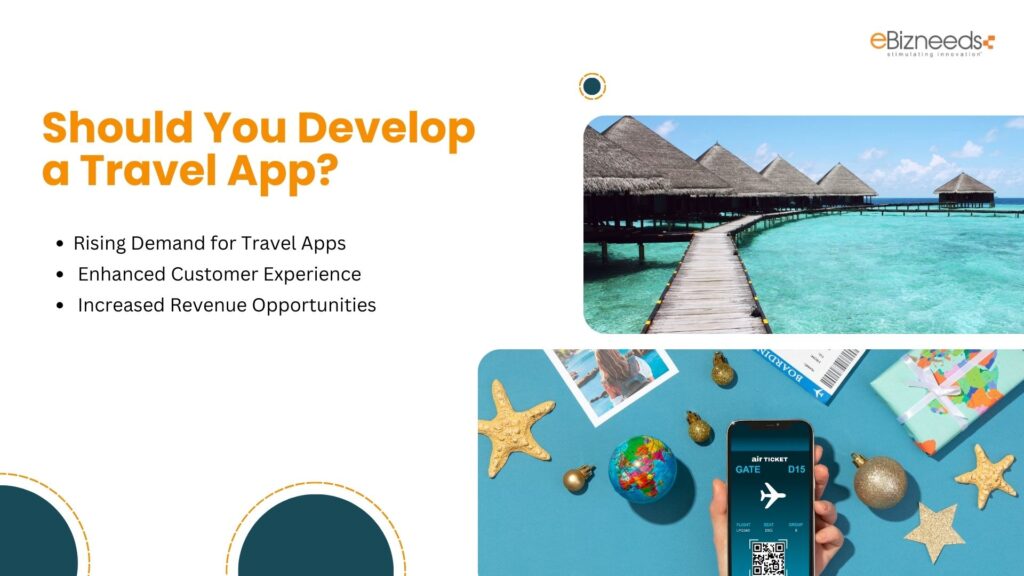


The travel industry is booming, and mobile apps are at the heart of it all.
But is a travel app the right choice for your business?
Here are three compelling reasons why you should consider developing a travel app:
1. Rising Demand for Travel Apps
Did you know that the global travel app market is projected to reach $12.6 billion by 2030?
With millions of people relying on mobile apps to plan trips, book accommodations, and explore destinations, there’s no better time to tap into this growing trend.
Having a travel app allows your business to meet customer needs while staying competitive.
2. Enhanced Customer Experience
Travel apps provide convenience at your customers’ fingertips.
From personalized itineraries to real-time flight updates, an app can make travel seamless and stress-free.
In fact, 80% of travelers prefer using apps for trip planning because they find them more reliable and user-friendly than websites.
An app not only attracts users but also keeps them engaged with your brand.
3. Increased Revenue Opportunities
With the right features, travel apps can become a source of consistent income.
Offering services like in-app bookings, exclusive deals, or even ad placements can significantly boost your revenue.
According to Forbes, businesses with mobile apps witness a 30% increase in customer retention and a 25% rise in revenue compared to those without.
Do you see the potential for your business in this market? A travel app could be your gateway to unlocking new opportunities and staying ahead of the competition.
Average Cost to Develop a Travel App
When it comes to calculating the cost to develop a travel app, there’s no one-size-fits-all answer.
The mobile app development cost depends on various factors, such as the complexity of the app, the platform (iOS, Android, or both), and the features you want to include.
However, we can provide you with a ballpark range to help you plan better.
| Basic Travel App | $25,000 to $40,000 | Includes essential features like user registration, basic search functionality, and a simple booking system. |
| Mid-Range Travel App | $50,000 to $80,000 | Adds features like advanced filters, payment gateways, real-time updates, and third-party integrations (e.g., maps, weather, APIs). |
| Feature-Rich Travel App | $100,000 to $150,000+ | Offers premium features like AI-driven recommendations, chatbots, multi-language support, AR for virtual tours, and more. |
On average, building a travel app takes anywhere from 3 to 9 months, depending on the scope of the project. The development timeline also affects the overall cost.
If you are looking for more details on the same, it’s highly recommended that you consult an mobile app development company.
They will be able to give you a better insight on the same.
Understanding these factors can help you better estimate your travel app development cost. Ready to dive deeper into what influences these numbers?
Let’s explore the factors that affect travel app development cost next.
Factors That Affect Travel App Development Cost (In-Depth Analysis)
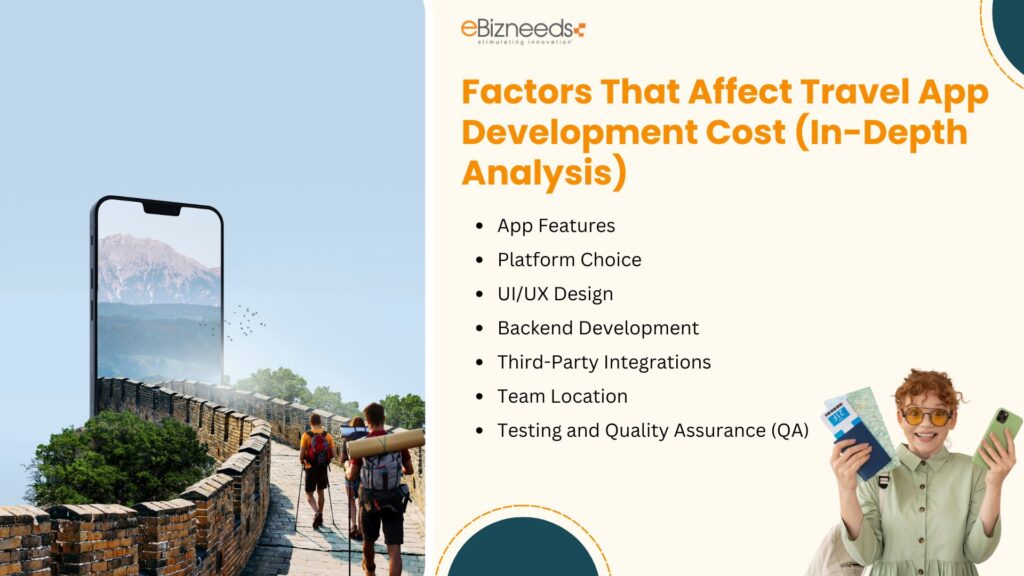


The cost to develop a travel app is influenced by a variety of factors.
Each factor plays a crucial role in determining the final budget and the app’s overall quality.
Let’s delve into the details, ensuring you understand the impact of each aspect on your travel app development cost.
1. App Features
The features you choose for your travel app significantly shape its functionality, user experience, and cost.
Here’s a breakdown:
| Feature | Development Time (hrs) | Cost Estimate ($) | Description |
| User Registration/Login | 40-60 | 1,000 – 2,500 | Basic email or phone login; costs increase with social media login integration. |
| Search & Advanced Filters | 80-120 | 2,000 – 4,500 | Includes searches for flights, hotels, or tours with filters like price, location, and reviews. |
| In-App Payments | 100-150 | 3,000 – 6,000 | Securely integrate popular payment methods like PayPal, Stripe, or credit cards. |
| Real-Time Notifications | 50-70 | 1,500 – 3,000 | Keeps users updated with booking confirmations, cancellations, and flight delays. |
| AI-Powered Recommendations | 150-200 | 4,500 – 10,000 | Suggests destinations, hotels, and deals based on user behavior and preferences. |
| Multilingual Support | 60-100 | 2,000 – 5,000 | Ensures your app is accessible to a global audience in multiple languages. |
| AR/VR Integration | 200-300 | 8,000 – 20,000 | Allows users to virtually explore destinations or hotels before booking. |
| Loyalty Programs | 80-120 | 2,000 – 4,000 | Engage users with rewards for frequent app usage and bookings. |
| Itinerary Management | 150-200 | 5,000 – 8,000 | Offers trip planning with features like calendars, reminders, and notes. |
The travel app development cost increases with the complexity of features.
While basic features are a must-have, advanced functionalities set your app apart from competitors, improving user engagement and driving more downloads.
2. Platform Choice
Another critical decision is choosing the platform, Android app development, iOS app development, or both.
This choice impacts your app’s reach, performance, and development cost.
| Platform | Estimated Cost ($) | Pros | Cons |
| Android app development cost | 25,000 – 50,000 | Access a larger global user base; cost-effective for initial launches. | Development time is longer due to device fragmentation. |
| iOS app development cost | 25,000 – 50,000 | High-spending audience; smoother user experience due to controlled ecosystem. | Smaller audience; strict app store submission guidelines. |
| Both (Native) | 40,000 – 80,000 | Reaches maximum users; platform-specific performance ensures quality. | Significantly more expensive and time-consuming to build and maintain. |
| Cross-Platform app development cost | 30,000 – 70,000 | Saves costs by reusing code; faster to develop. | May lack access to some platform-specific features. |
If your goal is to minimize travel app development cost while reaching a broad audience, starting with cross-platform development is a great choice.
However, for top-tier performance and platform-specific features, native apps remain the gold standard.
3. UI/UX Design
The design of your travel app creates the first impression on users.
An intuitive and visually appealing design not only engages users but also builds brand trust.
Here’s a breakdown of UI/UX design cost:
| UI/UX Scope | Cost ($) | Details |
| Basic Design | 5,000 – 10,000 | Standard layouts and basic visuals with minimal customizations. |
| Intermediate Design | 15,000 – 25,000 | Incorporates custom themes, animations, and consistent branding. |
| Advanced Design | 30,000 – 50,000 | Includes interactive elements, dynamic transitions, and premium aesthetics. |
Travel apps with seamless navigation, quick-loading interfaces, and personalized design see higher user retention rates.
For example, apps like Airbnb have set the standard for user-centric designs, focusing on simplifying the booking process and ensuring users can find what they need in a few taps.
4. Backend Development
Your app’s backend acts as the backbone for processing data and managing operations.
A simple backend might suffice for basic features, but more complex travel apps require robust backend systems.
| Backend Type | Cost Estimate ($) | Details |
| Simple Backend | 10,000 – 20,000 | Handles basic tasks like user authentication and a single database. |
| Moderate Backend | 25,000 – 40,000 | Supports dynamic data operations and multiple API integrations. |
| Complex Backend | 50,000+ | Includes advanced algorithms, real-time updates, and multi-layer architecture. |
If you’re wondering how much it costs to develop a travel app, keep in mind that a well-structured backend ensures scalability.



As your app grows, a solid backend minimizes downtime and delivers a smooth experience for users.
5. Third-Party Integrations
Integrations add extra functionality to your app by connecting it with external services.
| Integration | Cost ($) | Example |
| Maps API | 1,000 – 3,000 | Google Maps for directions and location-based services. |
| Weather API | 1,000 – 2,500 | Real-time weather updates for planned travel. |
| Payment Gateway API | 3,000 – 6,000 | Integration with PayPal, Stripe, or other secure payment providers. |
| Hotel Booking API | 5,000 – 8,000 | Access to real-time hotel availability through platforms like Booking.com. |
Including such integrations enhances your app’s user experience and functionality, making it indispensable for travelers while increasing your travel app development cost.
6. Team Location
The location of your development team significantly influences costs due to variations in hourly rates.
| Region | Hourly Rate ($) | Details |
| North America | 100 – 200 | Known for high-quality development but with premium pricing. |
| Europe | 50 – 100 | Offers a balance between cost and expertise. |
| Asia (India) | 20 – 50 | Most cost-effective option, with experienced developers available. |
Choosing a team in a region that matches your budget and quality requirements is essential for controlling your travel app development cost.
7. Testing and Quality Assurance (QA)
Testing ensures your app runs smoothly across different devices and platforms.
| Testing Scope | Cost Estimate ($) | Details |
| Basic QA | 5,000 – 8,000 | Covers testing for basic features and UI consistency. |
| Intermediate QA | 10,000 – 15,000 | Includes automated and manual testing for bugs and usability. |
| Advanced QA | 20,000+ | Comprehensive testing for performance, security, and multi-device compatibility. |
Apps that undergo thorough QA are more likely to succeed in competitive app stores, minimizing negative reviews and maximizing user satisfaction.
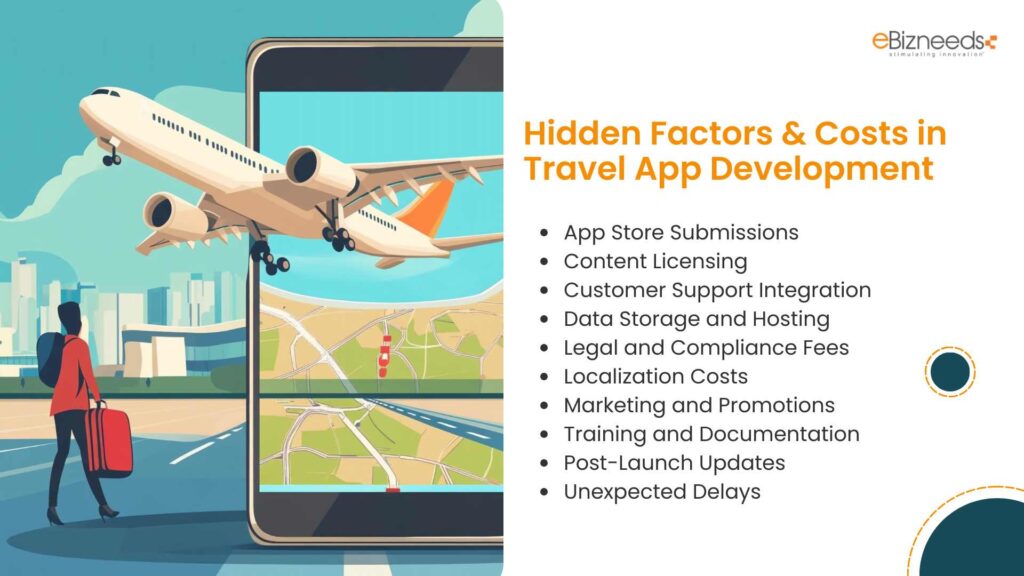


While the primary factors like features, platforms, and backend development shape the bulk of the travel app development cost, there are hidden factors that can unexpectedly increase your budget.
Being aware of these costs helps you prepare and avoid surprises. Let’s explore these hidden elements in detail.
1. App Store Submissions
Getting your travel app listed on popular app stores like Google Play or Apple App Store comes with both upfront and recurring costs.
| Cost Type | Details | Estimated Cost ($) |
| Google Play Fee | One-time developer registration fee for app submission. | 25 |
| Apple App Store Fee | Annual fee for developer membership to list your app. | 99 per year |
These fees may seem small, but if your app requires frequent updates or multiple listings, the costs can add up over time. It’s crucial to include these fees in your travel app development cost planning.
2. Content Licensing
If your app uses licensed content like destination images, videos, or booking data from third-party providers, you’ll need to account for licensing fees.
| Type of Content | Examples | Estimated Cost ($) |
| Stock Images | High-quality photos for destinations. | 500 – 2,000 annually |
| Stock Videos | Videos for AR/VR integrations. | 1,000 – 5,000 annually |
| Booking Data APIs | Partnering with Booking.com, Expedia, etc. | 5,000 – 10,000+ |
Licensing not only impacts costs but also ensures you avoid legal challenges when using copyrighted materials.
3. Customer Support Integration
Your travel app will need a customer support system to address user queries and complaints. Integrating customer support adds to the cost to develop a travel app but is vital for user satisfaction.
| Support Feature | Details | Estimated Cost ($) |
| Live Chat Integration | Real-time customer support through chat. | 2,000 – 5,000 |
| AI Chatbots | Automated support using AI-based bots. | 5,000 – 10,000 |
| Ticketing Systems | Manage and resolve user issues efficiently. | 3,000 – 7,000 |
Investing in these features ensures smooth user experience and builds trust with your audience.
4. Data Storage and Hosting
Travel apps generate and process a lot of data, from user profiles to booking details. Cloud hosting and data storage solutions are essential for scalability and performance.
| Storage Type | Examples | Cost Estimate ($/year) |
| Basic Cloud Hosting | AWS, Google Cloud (small apps). | 1,000 – 5,000 |
| Advanced Hosting | Scalable solutions for large apps. | 5,000 – 15,000 |
| Database Costs | Storage for user data, bookings. | 2,000 – 10,000 |
Cloud services also include recurring costs based on usage, which can increase as your user base grows.
5. Legal and Compliance Fees
Travel apps deal with sensitive user information, such as payment details and personal data. Meeting legal and compliance requirements adds to your costs.
| Compliance Type | Details | Estimated Cost ($) |
| GDPR Compliance | Necessary for apps targeting European users. | 3,000 – 7,000 |
| PCI DSS Certification | Required for secure payment processing. | 5,000 – 10,000 |
| Terms & Conditions/Privacy Policy | Legal drafting fees. | 500 – 2,000 |
Ignoring these requirements can lead to penalties, making compliance an essential investment in your travel app development cost.



6. Localization Costs
If you want your app to reach a global audience, you’ll need to localize it for different languages, cultures, and regions.
| Localization Component | Details | Estimated Cost ($) |
| Language Translation | Translate app content for international users. | 3,000 – 10,000 |
| Cultural Customization | Adjust UI and visuals to suit regional tastes. | 2,000 – 7,000 |
Localization enhances user experience, ensuring that travelers from around the world can use your app effectively.
7. Marketing and Promotions
Launching a travel app isn’t just about development; promoting it to your target audience requires a dedicated budget.
| Marketing Channel | Examples | Estimated Cost ($) |
| Social Media Ads | Facebook, Instagram, LinkedIn. | 1,000 – 5,000 monthly |
| Influencer Partnerships | Collaborations with travel bloggers. | 5,000 – 15,000 |
| App Store Optimization (ASO) | Optimizing your app for better rankings. | 1,000 – 3,000 |
Marketing is essential for gaining visibility and driving downloads, but it’s a recurring expense that can significantly impact your overall budget.
8. Training and Documentation
If your app includes an admin panel or complex backend operations, providing training for your team is crucial.
| Training Scope | Details | Estimated Cost ($) |
| Admin Panel Training | Tutorials for managing bookings, user data. | 2,000 – 5,000 |
| User Documentation | Manuals or guides for app users. | 1,000 – 3,000 |
This ensures your team can effectively use and manage the app post-launch.
9. Post-Launch Updates
After launching your app, you’ll need to roll out updates to fix bugs, add features, and stay competitive.
| Update Type | Examples | Estimated Cost ($) |
| Bug Fixes | Addressing minor and major issues. | 1,000 – 3,000 per update |
| Feature Upgrades | Adding new functionalities or integrations. | 5,000 – 15,000 per update |
A well-maintained app ensures high user retention and positive reviews.
10. Unexpected Delays
Project delays, whether caused by scope changes, technical hurdles, or miscommunication, can significantly increase your travel app development cost.
| Delay Cause | Examples | Potential Cost Increase ($) |
| Scope Creep | Adding unplanned features during development. | 10,000 – 20,000 |
| Technical Issues | Unexpected bugs or challenges. | 5,000 – 15,000 |
Being clear about your app’s scope and working with an experienced development team can minimize these risks.
Hidden factors often go unnoticed during initial planning but can significantly impact your travel app development cost.
Accounting for these costs upfront ensures a smoother development process and helps you stay on budget.
Popular Travel Apps & Cost to Clone Them
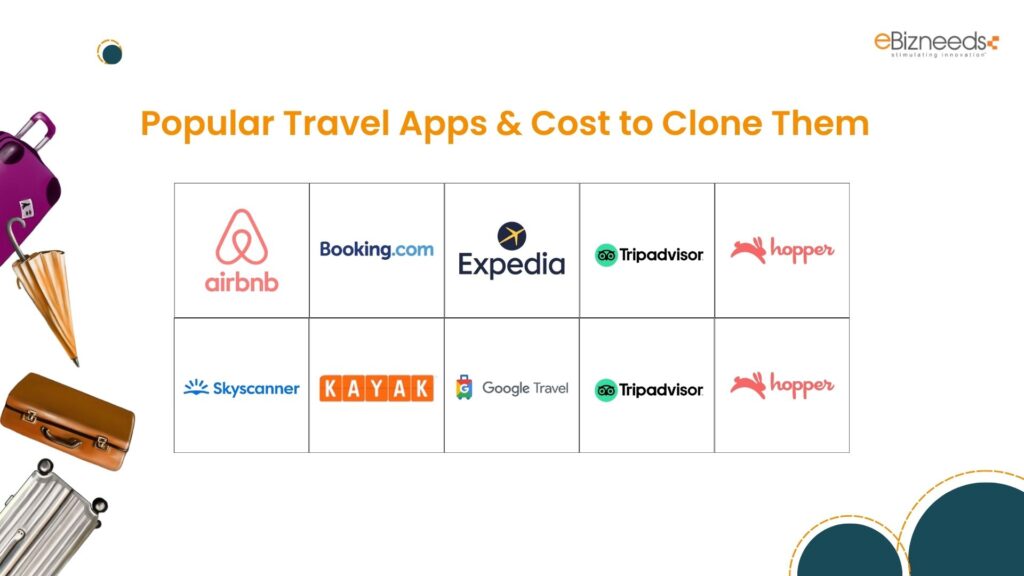


When thinking about developing a travel app, it’s helpful to analyze popular travel apps dominating the market.
These apps set benchmarks in features, usability, and user experience.
If you’re planning to create a similar app, understanding their development costs can help you estimate the budget for your project.
Here’s a detailed look at the top travel apps and the estimated cost to build a travel app like them:
1. Airbnb
A platform connecting travelers with hosts for unique stays and experiences.
Key Features: User profiles, advanced filters, wishlist creation, in-app messaging, secure payments.
Cost to Clone Airbnb: $80,000 to $150,000
2. Booking.com
One of the largest platforms for booking hotels, flights, and rental cars.
Key Features: Real-time availability, multi-platform booking, reviews, and dynamic pricing.
Cost to Clone Booking.com: $100,000 to $180,000
3. Expedia
An all-in-one app for booking flights, hotels, and car rentals.
Key Features: User accounts, rewards programs, customer support, and price tracking.
Cost to Clone Expedia: $120,000 to $200,000
4. TripAdvisor
Offers reviews, recommendations, and booking options for hotels, restaurants, and attractions.
Key Features: User-generated reviews, map integration, price comparison, and itinerary creation.
Cost to Clone TripAdvisor: $100,000 to $170,000
5. Hopper
A travel app that predicts flight and hotel prices to help users book at the best time.
Key Features: AI-driven price predictions, push notifications, and secure bookings.
Cost to Clone Hopper: $90,000 to $150,000
6. Skyscanner
A flight comparison tool that finds the best deals for travelers.
Key Features: Advanced search filters, multi-city flight booking, and price alerts.
Cost to Clone Skyscanner: $80,000 to $140,000
7. Kayak
A comprehensive travel search engine for flights, hotels, and car rentals.
Key Features: Custom search filters, trip organization, and price tracking.
Cost to Clone Kayak: $90,000 to $160,000
8. Google Travel
A travel planning tool that combines bookings, recommendations, and itinerary management.
Key Features: Integration with Google services, calendar synchronization, and personalized recommendations.
Cost to Clone Google Travel: $150,000 to $250,000
9. Roadtrippers
A unique app for planning road trips with route optimization and attractions along the way.
Key Features: Interactive maps, points of interest, and trip cost estimations.
Cost to Clone Roadtrippers: $70,000 to $120,000
10. Turo
A peer-to-peer car rental app allowing users to book vehicles directly from owners.
Key Features: Vehicle profiles, booking system, pricing calculators, and insurance integration.
Cost to Clone Turo: $80,000 to $140,000
Cloning a popular app doesn’t mean copying it directly; it involves taking inspiration from its features, improving them, and adding unique value.
For instance, while building a travel app like Airbnb, you could focus on niche markets such as eco-friendly stays or curated luxury properties.
Similarly, adding AR/VR for virtual property tours could make your app stand out.
Here’s How to Minimize Travel App Development Costs
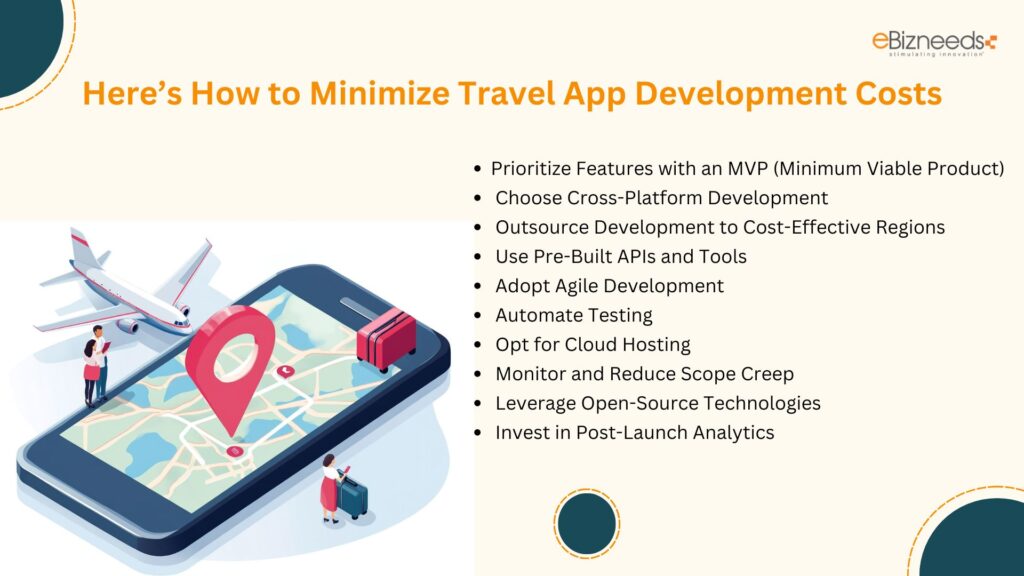


Developing a travel app doesn’t have to break the bank.
By carefully planning and implementing cost-saving strategies, you can significantly reduce your travel app development cost without compromising on quality.
Let’s explore some practical ways to minimize expenses while ensuring a high-quality outcome.
1. Prioritize Features with an MVP (Minimum Viable Product)
Instead of building a fully-featured app right away, start with an MVP that includes only the core functionalities.
This approach allows you to test the market, gather feedback, and make improvements without overspending.
| Feature Scope | Development Time (hrs) | Cost Estimate ($) |
| Core Features (MVP) | 300-500 | 20,000 – 50,000 |
| Full-Fledged App (Advanced) | 800-1,200 | 70,000 – 150,000 |
By focusing on essential features like search, booking, and payments, you can reduce initial costs by up to 50%.
2. Choose Cross-Platform Development
Building a cross-platform app using frameworks like Flutter or React Native is a cost-effective alternative to native app development.
| Approach | Development Cost ($) | Details |
| Native (iOS/Android) | 40,000 – 80,000 | Separate apps for each platform. |
| Cross-Platform | 30,000 – 60,000 | Single codebase for both platforms. |
Cross-platform development can reduce your travel app development cost by 30%-40%, while ensuring consistent performance across platforms.
3. Outsource Development to Cost-Effective Regions
Hiring developers from cost-effective regions like Asia or Eastern Europe can lower costs without compromising quality.
We are talking about development outsourcing.
| Region | Hourly Rate ($) | Estimated Cost ($) |
| North America | 100 – 200 | 80,000 – 150,000 |
| Europe | 50 – 100 | 50,000 – 100,000 |
| Asia (India) | 20 – 50 | 30,000 – 60,000 |
By outsourcing to countries with competitive rates, you can save up to 50% of your development budget.
4. Use Pre-Built APIs and Tools
Leverage third-party APIs for features like maps, payments, and weather to reduce custom development time and cost.
| API Integration | Cost Estimate ($) | Savings |
| Google Maps API | 1,000 – 3,000 | Avoids building location-based features from scratch. |
| Stripe/PayPal API | 3,000 – 6,000 | Saves development time for payment gateways. |
| OpenWeather API | 1,000 – 2,500 | Provides ready-to-use weather updates. |
Using pre-built tools can cut development time by 20%-30%, allowing you to launch faster and at a lower cost.
5. Adopt Agile Development
Agile development involves building your app in phases, allowing for flexibility and adjustments as you go. This reduces the risk of costly errors and rework.
| Development Approach | Cost Savings (%) | Details |
| Traditional | 0% | Fixed scope and timeline; less flexible. |
| Agile | 10%-20% | Iterative development with room for changes. |
Agile ensures you invest only in features that add value, optimizing your travel app development cost.
6. Automate Testing
Manual testing can be time-consuming and costly. Automating repetitive tests can save both time and money.
| Testing Type | Cost Estimate ($) | Savings (%) |
| Manual Testing | 10,000 – 15,000 | – |
| Automated Testing | 7,000 – 10,000 | Saves 20%-30% on recurring testing costs. |
Automation tools like Selenium or Appium can identify bugs quickly, ensuring a bug-free app while lowering QA costs.
7. Opt for Cloud Hosting
Cloud solutions like AWS or Google Cloud are more cost-efficient than maintaining your own servers.
| Hosting Solution | Cost Estimate ($) | Details |
| On-Premise Servers | 10,000 – 20,000/year | High initial setup and maintenance costs. |
| Cloud Hosting | 2,000 – 5,000/year | Pay-as-you-go pricing with scalability. |
Cloud hosting can save 50%-70% in infrastructure costs, while ensuring scalability as your app grows.
8. Monitor and Reduce Scope Creep
Adding unplanned features during development, also known as scope creep, can inflate your budget.
| Scenario | Cost Impact ($) | Savings |
| With Scope Creep | +10,000 – 20,000 | Increased costs due to additional features. |
| Without Scope Creep | -10,000 | Clear requirements save unnecessary expenses. |
Establishing clear project requirements and sticking to them helps avoid unnecessary delays and costs.
9. Leverage Open-Source Technologies
Using open-source tools and frameworks reduces licensing fees and development costs.
| Technology | Cost Savings (%) | Examples |
| Open-Source Frameworks | 20%-40% | React Native, Flutter, MongoDB. |
| Proprietary Tools | 0% | Paid tools like Oracle or Microsoft Azure. |
Open-source solutions can significantly reduce your travel app development cost, especially during the early stages of development.
10. Invest in Post-Launch Analytics
Tracking user behavior and performance metrics helps you make data-driven decisions for updates, preventing costly redesigns.
| Analytics Tool | Cost Estimate ($) | Benefits |
| Google Analytics | Free – 5,000/year | Tracks user engagement and app usage. |
| Firebase Analytics | Free | Monitors performance and crashes. |
Investing in analytics ensures your app evolves based on user needs, reducing the need for costly overhauls.
By applying these strategies, you can reduce your travel app development cost by up to 40%-50%, making it more feasible to launch a high-quality app within your budget.
eBizneeds – Here to Help You
At eBizneeds, we understand that developing a travel app is a significant investment, and we’re here to ensure you get the best value for your money.
As a leading Travel App Development Company, we specialize in creating innovative, user-friendly, and cost-efficient travel apps tailored to meet your specific needs.
Our team of experienced developers and designers takes a customer-first approach, ensuring your app delivers exceptional user experiences while staying within your budget.
From ideation to launch and beyond, we provide end-to-end solutions, including MVP development, advanced feature integration, and post-launch support.
Looking to build a travel app that stands out in a competitive market? eBizneeds is your trusted partner for turning your vision into reality.



Conclusion
Developing a travel app is a rewarding investment, especially in today’s tech-driven world where convenience is king.
While the cost to develop a travel app can vary significantly based on features, platforms, and hidden factors, careful planning and the right strategies can help you control expenses and deliver a high-quality product.
Whether you’re looking to build a simple booking app or a feature-rich platform like Airbnb or Expedia, understanding the factors influencing development costs ensures you’re well-prepared.
By leveraging cost-saving measures like MVP development, cross-platform solutions, and outsourcing, you can launch a competitive app while staying within your budget.
FAQs
The cost to develop a travel app ranges from $25,000 to $150,000 or more, depending on its complexity, features, and platform choice.
Both Android and iOS are excellent choices, but a cross-platform app can save costs while reaching a broader audience.
Essential features include user registration, search and filters, real-time notifications, in-app payments, and booking management.
Development time varies but typically takes 3 to 9 months, depending on the app’s complexity and scope.
You can minimize costs by starting with an MVP, using cross-platform development, outsourcing to cost-effective regions, and leveraging pre-built APIs.



Udai Singh Shekhawat is the SEO Content Strategist and team lead at eBizneeds, with deep expertise in fintech and eWallet app development. He crafts result-oriented content strategies tailored for Western and Australian markets, driving impactful brand engagement and user acquisition through innovative storytelling and industry-specific insights.
